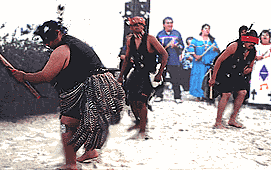Going Home Song
by Lois Pearlman

Going Home Songby Lois Pearlman
|

|
|
The spirits
of some 1,000 Native Americans, buried over 160 years ago in a makeshift cemetery next to the Sonoma Mission, can finally rest in peace.
To the strains of the Coast Miwok "Going Home Song," sung in a cherished language once almost forgotten, representatives from some of the same tribes as the long-buried Indians blessed the cemetery during a May 10 ceremony held at the mission.
| |
|
The ceremony
was a first phase of a project which will result in the placing of memorial plaques on the outside wall of the Mission San Francisco Solano, located at the intersection of East Spain Street and First Street East in the town of Sonoma in northern California.
Built in 1823, this final and northernmost of the California missions, is now part of the California State Park system.
| |
|
This memorial
is the brainchild of Ed Castillo, an archeology professor and chairman of Sonoma State University's Native American Studies Department. With a $1,000 donation from the Sonoma State Historic Parks Association, Castillo and another colleague transcribed the names of the Indians buried in the mass graves at the mission from death records kept by mission priests.
He recalled that serious interest focused on the mission Indians for the first time in 1988 when the Catholic Church was considering the beatification of Father Junipero Serra, a Spanish priest whom Castillo described as the "architect" of the California mission system. "A cry went up from the local (Native American) community," Castillo said. They objected to the beatification of Serra because thousands of Native people had died under the system, which used Indian labor to construct and operate the missions between 1769 and 1934.
| |
|
According
to Breck Parkman, an archaeologist for the California State Department of Parks, Native Americans did all of the work at the missions under the supervision of a priest and four to six soldiers.
He said people from the local Pomo, Coast Miwok, Patwin and Wappo tribes may have initially come to the missions on their own, but when they attempted to leave they were hunted down and returned. Parkman is currently involved in a five-year archaeological study at the Petaluma Adobe which he hopes will offer more insight into the lives of Native Americans who lived at the missions. He admits that there is a serious lack of information available to visitors to the various missions about the role that Native Americans played. "We don't want to look back and judge the past based on present-day ideas, but we don't want to whitewash it either," he said. Eventually, Castillo says, he would like to see similar memorials at all of the 21 surviving missions, as well as more balanced presentations about what actually went on at the missions He envisions the memorials as joint projects between the Native American communities and the two entities that currently own the missions -- the Catholic Church and the California Department of Parks. And he believes they would have the effect of reconciling "the defenders and the detractors of the Franciscan missionaries." For now efforts are centered on the memorial at the mission in Sonoma, where a committee of Native Americans and non-native people are raising funds for its completion. The California State Parks Foundation, a private non-profit that raises money for state parks has donated $2,500 to the memorial and funds raised at a buffet dinner held after the blessing ceremony will also go towards the project. Observing the May 10 festivities taking place in the mission's courtyard, park aide Peggy Fontenot made a comment which seemed to sum up the feelings of everyone there. "It's been a long time coming," she said. |

Albion Monitor May 21, 1997 (http://www.monitor.net/monitor)
All Rights Reserved.
Contact rights@monitor.net for permission to reproduce.
